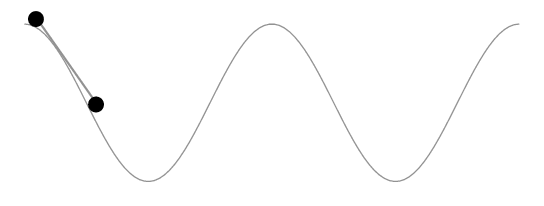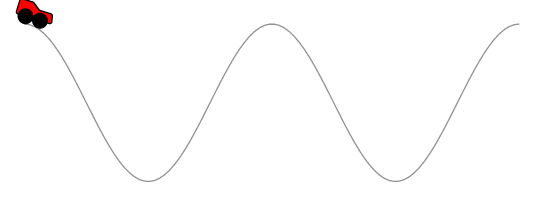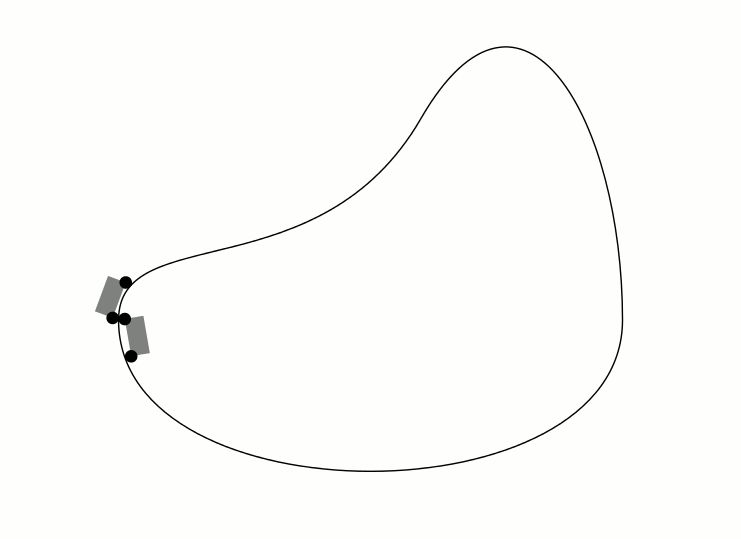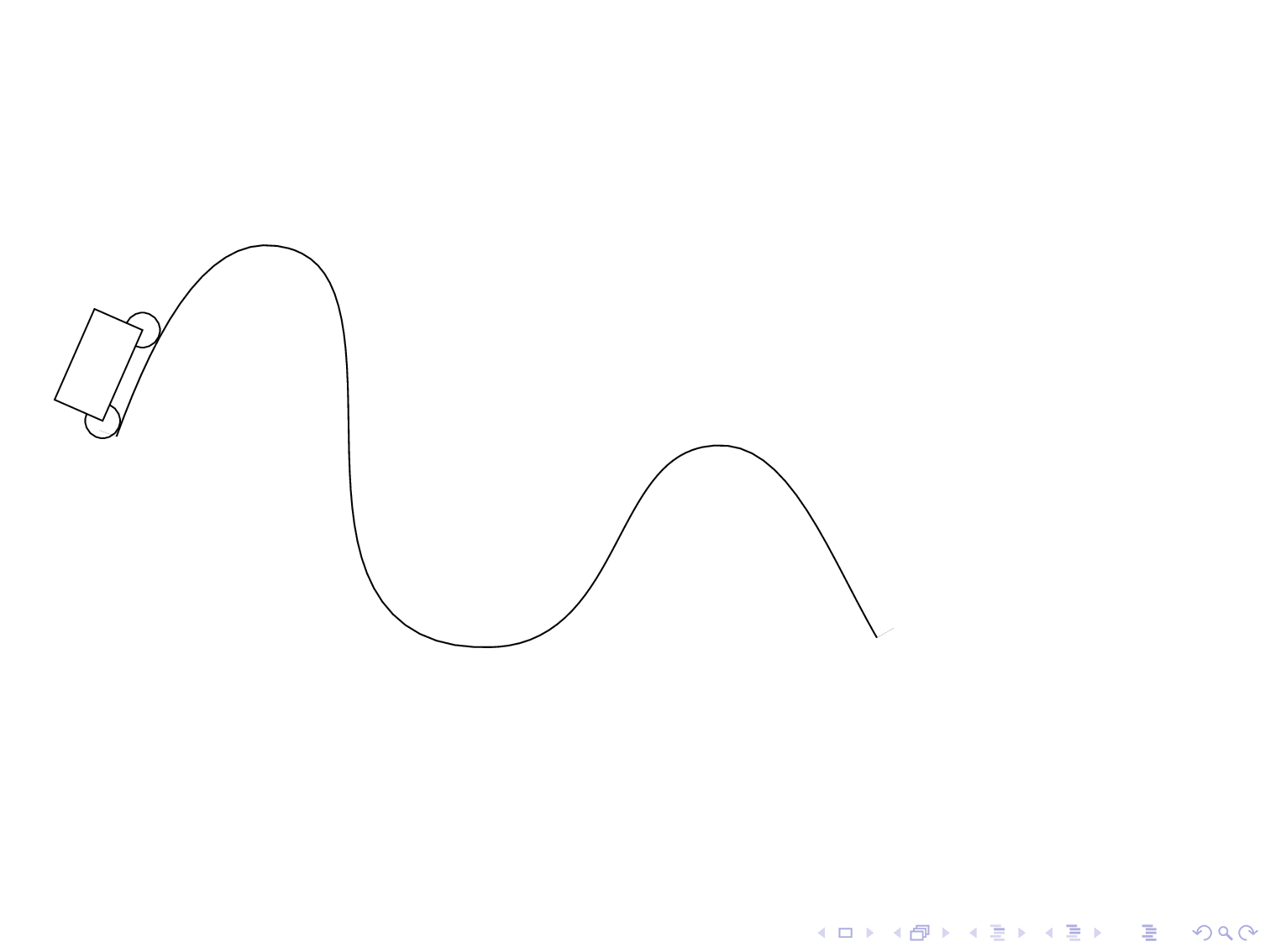
对于任意参数平滑曲线,如何使汽车的长度保持不变?
\documentclass[pstricks,border=12pt]{standalone}
\usepackage{pst-plot,pst-node}
\pstVerb
{
tx@Derive begin
/EvalVariable { 2 index (t) eq { (1) } { (0) } ifelse 4 -1 roll exch 6 2 roll } def
end
}
\def\x{t}
\def\y{2*cos(t)}
\def\xx{Derive(1,\x)}
\def\yy{Derive(1,\y)}
\def\rr{sqrt((\xx)^2+(\yy)^2)}
\def\Nx{-\yy/\rr}
\def\Ny{\xx/\rr}
\def\R{.2}
\def\xP{\x+\R*\Nx}
\def\yP{\y+\R*\Ny}
\begin{document}
\multido{\rx=.0+.3,\ry=.4+.3}{41}{%
\begin{pspicture}[algebraic](-.2,-2.2)(\dimexpr\psPiFour cm+.2cm,2.2)
\psparametricplot[linecolor=gray,plotpoints=100]{0}{TwoPi 2 mul}{\x|\y}
\curvepnodes[plotpoints=2]{\rx}{\ry}{\xP|\yP}{P}
\pspolygon*[linecolor=gray](P0)(P1)([offset=-.5]{P0}P1)([offset=.5]{P1}P0)
\qdisk(P0){\R}\qdisk(P1){\R}
\psparametricplot[linecolor=red,linewidth=2pt,plotpoints=100]{0}{\rx}{\xP|\yP}
\end{pspicture}}
\end{document}

评论 Herbert 的解决方案
作为评论来说,它太长了。赫伯特的解决方案显然保持了由车轮界定的曲线段的长度不变,而不是汽车的长度不变。以下动画显示了这一点。
\documentclass[pstricks,border=12pt]{standalone}
\usepackage{pstricks-add}
\pstVerb
{
tx@Derive begin
/EvalVariable { 2 index (t) eq { (1) } { (0) } ifelse 4 -1 roll exch 6 2 roll } def
end
}
\def\x{t}
\def\y{2*cos(t)}
\def\xx{Derive(1,\x)}
\def\yy{Derive(1,\y)}
\def\rr{sqrt((\xx)^2+(\yy)^2)}
\def\Nx{-\yy/\rr}
\def\Ny{\xx/\rr}
\def\R{.2}
\def\xP{\x+\R*\Nx}
\def\yP{\y+\R*\Ny}
\begin{document}
\multido{\iA=1+1,\iB=10+1}{40}{%
\begin{pspicture}[algebraic](-.2,-2.2)(\dimexpr\psPiFour cm+.2cm,2.2)
\psparametricplot[linecolor=gray,plotpoints=100]{0}{TwoPi 2 mul}{ \x | \y }
\pscurvepoints[plotpoints=50]{0}{TwoPi 2 mul}{ \xP | \yP }{P}
\pspolylineticks[ticksize=0 0,metricInitValue=1,Os=1,Ds=.3]{P}{ ds }{1}{50}%
\pspolygon*[linecolor=gray](PTick\iA)(PTick\iB)([offset=-.05]{PTick\iA}PTick\iB)([offset=.05]{PTick\iB}PTick\iA)
\qdisk(PTick\iA){\R}\qdisk(PTick\iB){\R}
\end{pspicture}%
}
\end{document}

答案1
好的,开始吧 :) 此代码的工作原理与 Asymptote、Metapost 和 TikZ 答案类似。首先创建一条与原始轨道路径平行的路径,后轮以恒定速度前进,前轮的位置计算为以后轮为中心的圆与平行轨道路径的交点。
该代码基于pst-intersect包。最大的部分是需要创建一条与另一条路径平行的路径:
\documentclass[pstricks,border=12pt]{standalone}
\usepackage{pst-plot,pst-node,pst-intersect}
\def\x{t}
\def\y{2*cos(t)}
\makeatletter
\pstVerb{ \pst@intersectdict
/ExtrudePath {
/@myshift exch def
[ exch
{
{ aload pop } forall
4 copy VecSub
2 copy tx@Dict begin Pyth end dup 3 1 roll div 3 1 roll div exch % normalized
@myshift VecScale
-90 matrix rotate dtransform 2 copy 8 -2 roll VecAdd 6 2 roll VecAdd
[ 5 1 roll ] ArrayToPointArray
counttomark 1 roll
} forall ]
} bind def
/CleanupPath {
[ exch
5 dict begin
dup length dup /N exch def 1 gt {
/i 1 def
dup 0 get /A exch def
{
dup i get /B exch def
A B IntersectLines pop /tA exch def pop pop
{
i N 1 sub eq { exit } if
/i i 1 add def
dup i get A exch IntersectLines pop
dup 0 get tA 0 get lt { %(skip current line) ==
/tA exch def /B exch def pop
} { % (use current line) ==
pop pop pop /i i 1 sub def exit
} ifelse
} loop
A tA LoadLineIntersectionPoints dup
[ A 0 get 3 -1 roll ] counttomark 1 roll
/A [ 3 -1 roll B 1 get ] def
/i i 1 add def
i N eq { A counttomark 1 roll exit } if
} loop
pop ]
} if
end
} bind def
/GetCurvePointAtLength {
3 dict begin
/l_to exch def
/L 0 def
/segm 0 def
PreparePath [ exch aload pop counttomark -1 2 { 1 roll } for ]
dup 0 get L 3 -1 roll
{
dup { aload pop } forall
tx@Dict begin Pyth2 end
dup L add /L exch def
L l_to gt { 4 2 roll pop pop exit } { /segm segm 1 add def pop pop } ifelse
} forall
L l_to sub exch div neg 1 add dup segm add 3 1 roll [ exch ]
LoadLineIntersectionPoints aload pop
end
} bind def
end
}%
\def\psGetCurveCoorAtLength#1#2{%
\pst@intersectdict
currentdict /\PIT@name{#1} known not {
(You haven't defined the curve or path '#1') ==
} if
\PIT@name{#1} #2 \pst@number\psxunit\space mul
GetCurvePointAtLength 3 -1 roll pop
\tx@UserCoor
end
}%
\def\pssaveparallelpath#1#2#3{%
\pstVerb{ \pst@intersectdict
/\PIT@name{#1} load PreparePath #3 \pst@number\psxunit mul
ExtrudePath
CleanupPath
[ exch dup dup length 1 sub get 0 get aload pop /movetype 4 -1 roll
{ 1 get aload pop /linetype } forall counttomark -3 roll ]
/\PIT@name{#2} exch def
end }%
}
\def\psGetFrontWheelCoor#1#2#3{%
\pst@intersectdict
\PIT@name{#1} /\PIT@name{#2} get #3 \pst@number\psxunit\space mul
GetCurvePointAtLength pop pop /t_val exch def
\PIT@name{#1} /\PIT@name{#2@t} get
{ dup t_val gt { exit }{ pop } ifelse } forall
\PIT@name{#1} /\PIT@name{#2} get
PreparePath dup length 1 sub
3 -1 roll dup dup
cvi sub 4 1 roll
cvi sub get
PointArrayToArray
tx@FuncDict begin 2 dict begin
dup length 2 idiv 1 sub /BezierType exch def /Points exch def GetBezierCoor
end end end
\tx@UserCoor
}
\makeatother
\def\Car{%
\ncline[linestyle=none]{RearWheel}{FrontWheel}
\ncput[nrot=:U]{\psline[linearc=0.05,fillstyle=solid,fillcolor=red](0,0)(0.5,0)(0.45,0.25)(0.1,0.25)(-0.1,0.4)(-0.45,0.4)(-0.45,0)(0,0)}
\pscircle[fillstyle=solid, fillcolor=black](FrontWheel){\WheelRadius}
\pstracecurve[fillstyle=solid,fillcolor=black]{RearWheel}}
\begin{document}
\multido{\r=0+0.45}{95}{%
\def\CarLength{0.4}
\def\WheelRadius{0.2}
\begin{pspicture}[algebraic](-.2,-2.2)(\dimexpr\psPiFour cm+.2cm,2.2)
\pssavepath[linestyle=none]{A}{\psparametricplot[plotpoints=100]{0}{TwoPi 2 mul}{\x|\y}}
\pstracecurve[linecolor=gray]{A}
\pssaveparallelpath{A}{B1}{\WheelRadius}%
\pssaveparallelpath{A}{B2}{-\WheelRadius}%
\pssavepath[linestyle=none]{B}{%
\pstracecurve{B1}
\psparametricplot[plotpoints=10]{Pi -0.5 mul}{Pi 0.5 mul}{12.56637+0.2*cos(t)|2-0.2*sin(t)}
\pstracecurve[tstart=99,tstop=0]{B2}
\psparametricplot[plotpoints=10]{Pi 0.5 mul}{Pi 1.5 mul}{0.2*cos(t)|2-0.2*sin(t)}}%
\pnode(!\psGetCurveCoorAtLength{B}{\r}){RearWheel}
\pssavepath[linestyle=none]{RearWheel}{\pscircle(RearWheel){\WheelRadius}}
\pssavepath[linestyle=none]{CircIsect}{\pscircle(RearWheel){\CarLength}}
\psintersect[name=I]{B}{CircIsect}
\pnode(!\psGetFrontWheelCoor{I}{B}{\r}){FrontWheel}
\Car
\end{pspicture}}
\end{document}

在你的情况下我应该提到,代码还没有考虑到所有可能或不可能的路径绕行:)
答案2
编译速度有点慢,而且有些地方不准确。
\documentclass[tikz,border=5]{standalone}
\usetikzlibrary{decorations}
\makeatletter
\pgfdeclaredecoration{cart}{start}{
\state{start}[width=0pt, next state=move,
persistent precomputation={
\ifx\pgfdecorationcartdistance\pgfutil@empty%
\else%
\pgfmathparse{\pgfdecorationcartdistance/\pgfdecoratedpathlength}%
\let\pgfdecorationcarttime=\pgfmathresult%
\fi%
}]{}
\state{move}[width=\pgfdecorationcarttime*\pgfdecoratedpathlength,
next state=pre-calculate]{}
\state{pre-calculate}[width=1pt, next state=calculate]{
\pgfcoordinate{cart-start}{\pgfpointorigin}%
}
\state{calculate}[width=1pt,
persistent postcomputation={
\pgfpointdiff{\pgfpointanchor{cart-start}{center}}%
{\pgfpointanchor{cart-end}{center}}%
\pgfmathveclen{\the\pgf@x}{\the\pgf@y}%
\ifdim\pgfmathresult pt>\pgfdecorationcartlength\relax
\def\pgf@decorate@next@state{final}
\fi
}
]{ \pgfcoordinate{cart-end}{\pgfpointorigin} }
\state{final}{%
\pgftransformreset
\pgftransformshift{\pgfpointanchor{cart-start}{center}}%
\pgfmathanglebetweenpoints{\pgfpointanchor{cart-start}{center}}{\pgfpointanchor{cart-end}{center}}%
\pgftransformrotate{\pgfmathresult}%
\path pic [transform shape] {cart};
}
}
\begin{document}
\pgfkeys{/pgf/decoration/.cd,
cart length/.store in=\pgfdecorationcartlength,
cart height/.store in=\pgfdecorationcartheight,
cart time/.store in=\pgfdecorationcarttime,
cart distance/.store in=\pgfdecorationcartdistance,
cart wheel radius/.store in=\pgfdecorationcartwheelradius,
cart length=0.375cm,
cart height=0.25cm,
cart time=0.5,
cart distance=,
cart wheel radius=0.0625cm,
}
\tikzset{cart/.pic={
\fill [gray] (0cm, \pgfdecorationcartwheelradius)
rectangle (\pgfdecorationcartlength, \pgfdecorationcartheight);
\fill [black] (0cm, \pgfdecorationcartwheelradius)
circle [radius=\pgfdecorationcartwheelradius];
\fill [black] (\pgfdecorationcartlength, \pgfdecorationcartwheelradius)
circle [radius=\pgfdecorationcartwheelradius];
}}
\foreach \p in {0,...,49}{%
\begin{tikzpicture}
\useasboundingbox (-1, -2) rectangle (6, 3);
\draw [postaction={decoration={cart, cart time=\p/50}, decorate},
postaction={decoration={cart, cart time=\p/50, reverse path}, decorate}]
(0,0) .. controls ++(90:1) and ++(240:2) .. (3,2)
.. controls ++(60:2) and ++(90:2) .. (5,0) .. controls ++(270:2)
and ++(270:2) .. cycle;
\end{tikzpicture}
}
\end{document}

答案3
这是一个渐近线解决方案,改编自我的回答这里:
unitsize(5cm);
import graph;
import animation;
real wheelradius = 0.1, wheeldistance = 1.0;
pair torusknot(real t) {
int p = 3, q=5;
real r = cos(q*t) + 2;
return (r*cos(p*t), r*sin(p*t));
}
path loop = graph(torusknot, 0, 2pi, operator..) & cycle;
//Where will a wheel center be when it's tangent to the loop at path time t?
pair wheelcenter(real t) {
return point(loop, t) + wheelradius*(rotate(90)*dir(loop,t));
}
//This path is for computation, not drawing:
path wheelpath = graph(wheelcenter, 0, length(loop), operator ..) & cycle;
void drawcart(pair trailingwheel, pair leadingwheel = trailingwheel + (wheeldistance, 0)) {
draw(trailingwheel -- leadingwheel, gray);
filldraw(circle(c=trailingwheel, r=wheelradius));
filldraw(circle(c=leadingwheel, r=wheelradius));
}
//t is specified in arclength
void drawcart(real t) {
pair trailingwheel = arcpoint(wheelpath, t);
pair estimateleading = arcpoint(wheelpath, t + wheeldistance);
path samedist = circle(c=trailingwheel, r=wheeldistance);
pair[] intersections = intersectionpoints(samedist, wheelpath);
pair leadingwheel = intersections[0];
for (pair candidate : intersections) {
if (length(candidate - estimateleading) < length(leadingwheel - estimateleading))
leadingwheel = candidate;
}
drawcart(trailingwheel, leadingwheel);
}
//Draw the loop:
draw(loop);
animation A;
int n = 200;
real length = arclength(wheelpath);
for (int i = 0; i < n; ++i) {
save();
drawcart(i*length/n);
A.add();
restore();
}
A.movie(delay=300);
结果:

答案4
\documentclass{beamer}
%\url{http://tex.stackexchange.com/q/175874/86}
\usepackage{tikz}
\usetikzlibrary{%
% Intersections is needed to work out where the front of the car will be
intersections,%
% Hobby is just to get a track that doesn't have a ``nice'' function
hobby,%
% Calc is to make it easy to draw the car, and to make the clipping path easy to compute
calc,%
% Decorations makes it easy to locate the car on the track
decorations.markings%
}
% Converts the ``beamer@slideinframe'' to a LaTeX counter to make it easier to animate
\makeatletter
\def\c@slideinframe{\beamer@slideinframe}
\makeatother
\begin{document}
% The track appears to be 125mm long, give or take the length of the car, so we animate over that length
\begin{frame}<1-125>
\begin{tikzpicture}
% Set the position of the car dependent on the slide number
\pgfmathsetmacro\xpos{\the\value{slideinframe}}
% Length of the car
\def\clen{10mm}
% Radius of car wheel
\def\crad{5pt}
% We're going to use this path a few times, so we save it for easy restoration.
% This also sets the bounding box and marks the position of the back wheel of the car.
\path[
use as bounding box,
use Hobby shortcut,
save Hobby path={track},
decoration={
markings,
mark=at position {\xpos mm} with {\coordinate (bwheel);}
},
decorate
]
([out angle=70]0,0) .. (2,2) .. (4,-2) .. (6,0) .. ([in angle=120]8,-2);
\begin{scope}
% Now we draw the track.
% The actual track is offset from the track path by the radius of the car wheels.
% Since an offset path is unlikely to be a bezier curve, we can't draw it directly.
% So we cheat: we draw a thick path of the right width but clip it against the original path to only draw one side of it.
% Then we overlay with a narrower white path (this is how the ``double'' key works, except that we only want one of the sides not both, hence the clip).
% The clip path consists of the track path and a lower box, large enough to encompass the thickened track.
\clip (8,-2) |- ($(current bounding box.south)+(0,-2*\crad)$) -| (0,0) [restore and use Hobby path={track}{}];
\draw[restore and use Hobby path={track}{disjoint}, name path global=track,line width=2*\crad+1pt];
\end{scope}
\draw[restore and use Hobby path={track}{disjoint}, name path global=track,line width=2*\crad,white];
% This path is a circle of radius the length of the car.
% We use this to intersect with the track path to find out where the front wheel will be.
\path[name path=base] (bwheel) circle[radius=\clen];
% The intersections library gives us one or two intersections.
% We want the front one, so we order the intersections by the track path and then take the last one.
\path [name intersections={of=track and base,total=\carint,sort by=track}] coordinate (fwheel) at (intersection-\carint);
% We draw the wheels.
\draw (bwheel) circle[radius=5pt] (fwheel) circle[radius=5pt];
% And lastly the car, using the calc library to draw the sides perpendicular to the base.
\draw[fill=white] (bwheel) -- (fwheel) -- ($(fwheel)!15pt!-90:(bwheel)$) -- ($(bwheel)!15pt!90:(fwheel)$) -- cycle ;
\end{tikzpicture}
\end{frame}
\end{document}



